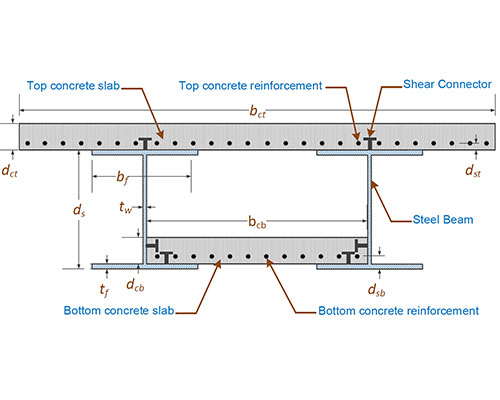

Research Reports |
| Title: | Evaluation of a New Double-Composite Simply-Supported Steel Bridge System |
| Authors: | Hussam Mahmoud and Emad Hassan |
| University: | Colorado State University |
| Publication Date: | Mar 2023 |
| Report #: | MPC-23-495 |
| Project #: | MPC-508 |
| TRID #: | 01917125 |
| Keywords: | beams, bridge design, bridge superstructures, composite structures, deflection, finite element method, mathematical models, steel bridges |
| Type: | Research Report – MPC Publications |
 Built-up plate girders are considered a viable solution for long-span bridges due to their ability to meet the requirements for deflection limits. They are made up of flanges, webs, and stiffeners, which are typically welded together. The webs in plate girders are relatively thin, which requires the addition of transverse stiffeners to achieve the required shear capacity. The thin webs can also corrode through fairly quickly once corrosion begins. From a maintenance perspective, the added stiffeners to enhance the shear capacity can trap debris and moisture on the bottom flange. This can give rise to corrosion fatigue, which is not addressed in the AASHTO Design Specifications. On the other hand, the use of rolled beams in steel bridges can be very advantageous since the webs are an integral part of the flanges in that the beams are rolled out of one piece of steel and the webs are significantly thicker than built-up girder webs. Therefore, there is no need for transverse stiffeners to enhance the shear capacity of the web. From a maintenance and deterioration perspective, the beams have smoother lines with no stiffeners to trap moisture and debris on the bottom flange.
Built-up plate girders are considered a viable solution for long-span bridges due to their ability to meet the requirements for deflection limits. They are made up of flanges, webs, and stiffeners, which are typically welded together. The webs in plate girders are relatively thin, which requires the addition of transverse stiffeners to achieve the required shear capacity. The thin webs can also corrode through fairly quickly once corrosion begins. From a maintenance perspective, the added stiffeners to enhance the shear capacity can trap debris and moisture on the bottom flange. This can give rise to corrosion fatigue, which is not addressed in the AASHTO Design Specifications. On the other hand, the use of rolled beams in steel bridges can be very advantageous since the webs are an integral part of the flanges in that the beams are rolled out of one piece of steel and the webs are significantly thicker than built-up girder webs. Therefore, there is no need for transverse stiffeners to enhance the shear capacity of the web. From a maintenance and deterioration perspective, the beams have smoother lines with no stiffeners to trap moisture and debris on the bottom flange.
Despite their advantages, rolled beams are limited in size, which imposes constraints on their use to relatively short spans due to deflection requirements. The main overarching goal of this project is to propose a new superstructure system, which utilizes rolled beams in combination with reinforced concrete slabs, resting on the bottom flanges of the beams, to enhance the deflection of the system and allow for longer spans to be built using rolled beams. This was realized through various tasks that include 1) devising a mathematical/analytical formulation that allows for rapid assessment of the non-linear response of double composite bridges, 2) developing finite element models using commercial software that can capture the overall linear and non-linear response of the bridge in addition to the response of various components, 3) validating the results of the mathematical formulation against the results of the finite element models, and 4) using the developed tools to compare and assess the improvements in deflection and moment capacity for double composite bridges over single composite bridges.
The significance of this work includes the formulation of the mathematical model, which can readily be used by structural engineers to evaluate the behavior of the bridges, the development of the linear and non-linear models, and the parametric studies and the associated findings. The results of the numerical finite element analyses were shown to be in very good agreement with the mathematical model. The results showed substantial enhancement of the overall bridge deflection and capacity for double composite sections over their single composite counterparts.
Mahmoud, Hussam, and Emad Hassan. Evaluation of a New Double-Composite Simply-Supported Steel Bridge System, MPC-23-495. North Dakota State University - Upper Great Plains Transportation Institute, Fargo: Mountain-Plains Consortium, 2023.